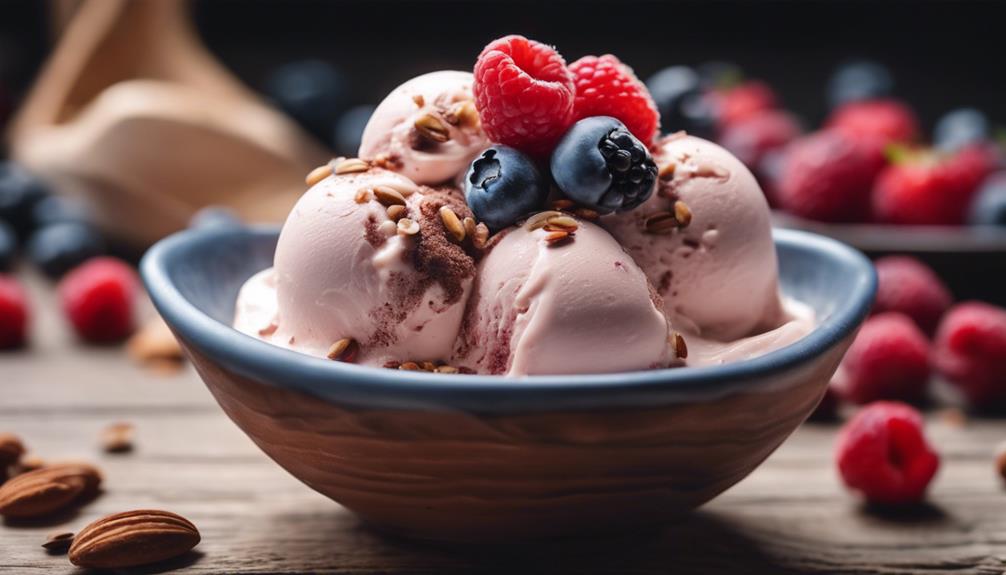If you’ve ever wondered why ice cream has carbohydrates, it’s primarily due to added sugars and lactose in milk. The sugars are responsible for enhancing sweetness and flavor. The carbohydrate content can vary from 15-30g per serving, depending on the flavor. Different types and flavors of ice cream contain varying amounts of sugar. Ice cream with higher sugar content tends to have more carbohydrates. Maintaining a balance between carbohydrates and sugar is crucial for the nutritional value of ice cream. Excessive sugar consumption from ice cream can result in health issues such as obesity and diabetes. It is important to be mindful of sugar intake for a healthy diet. Educating yourself on the sources of carbs in ice cream and their health effects can help you make informed choices about your diet.
Key Takeaways
- Carbohydrates in ice cream come from added sugars like sucrose and natural lactose in milk.
- Sugar is a key component in ice cream, affecting sweetness and flavor.
- Carb content ranges from 15-30g per serving, varying with flavor and type.
- High-carb ice cream has more added sugars, impacting overall carb count.
- Understanding carb sources aids in making informed dietary choices for balanced nutrition.
Carbohydrates in Ice Cream
When enjoying ice cream, be mindful of the carbohydrates it contains, as they stem from sugars added during production and naturally occurring lactose in milk. Carbs in ice cream play a pivotal role in providing energy, but the added sugars can lead to blood sugar spikes, making it important to monitor intake.
The carbohydrate content in ice cream can range from 15-30g per serving, depending on the flavor and type. For individuals following specific dietary plans or managing blood sugar levels, understanding these carbs is vital. Some opt for low-carb or no-added-sugar ice cream options to better control their carbohydrate intake.
Sugar Content in Ice Cream

You'll find that sugar is a key component in ice cream, contributing to its sweetness and overall flavor.
The sugar content in ice cream varies depending on the type and flavor you choose to indulge in.
Keep in mind that excessive sugar intake from ice cream can have negative effects on your health, so it's important to be mindful of your consumption.
Sugar in Ice Cream
Ice cream's sugar content, derived primarily from added sugars like sucrose, greatly contributes to its overall sweetness.
When it comes to sugar in ice cream, here are some significant points to keep in mind:
- The sugar content in ice cream can vary, typically ranging from 12-24g per serving, depending on the flavor and type.
- Ice cream's high sugar content contributes to its carbohydrate count, providing a quick source of energy.
- Consuming ice cream with excessive sugar can lead to health issues such as obesity and diabetes.
- Checking nutrition labels is essential for identifying the grams of sugar in ice cream and making informed dietary choices.
- Being mindful of added sugars in ice cream is vital for managing your overall sugar intake and maintaining a balanced diet.
Carbohydrates Content
Understanding the carbohydrate content in ice cream is fundamental for making informed dietary choices and managing your sugar intake effectively. Ice cream contains carbs primarily in the form of sugar, contributing to its sweetness and energy content. The sugar content in ice cream varies depending on the type and flavor, impacting the overall carbohydrate count.
These carbs can stem from added sugars, natural milk sugars like lactose, or other sweetening ingredients used in the ice cream's production. High-carb ice cream options typically contain more added sugars, while low-carb alternatives may utilize sugar substitutes or fewer sweeteners.
Being aware of the carbohydrate content in ice cream is vital for individuals who are monitoring their sugar intake or following specific dietary guidelines. Consider checking the nutrition labels to identify the sugar content in different ice cream varieties and choose options that align with your dietary needs and preferences.
Impact on Health
How does the sugar content in ice cream affect your health?
Ice cream, while delicious, can have a significant impact on your health due to its high sugar content. Here are some key points to keep in mind:
- Health Effects: Consuming ice cream high in sugar can lead to various health issues such as obesity and diabetes.
- Weight Gain: Excessive consumption of ice cream with high sugar content can contribute to weight gain over time.
- Sugar Intake: Monitoring your sugar intake from ice cream is important for maintaining a balanced diet.
- Carbs in Your Diet: The carbs from added sugars in ice cream can add up quickly in your daily carb intake.
- Impact on Health: Being mindful of the sugar content in ice cream is vital for managing your overall health and well-being.
Carbs and Health Impacts

Let's talk about the carbs in ice cream and how they can affect your health.
Excessive carb intake from ice cream can lead to weight gain and increase the risk of conditions like diabetes and heart disease.
Understanding the impact of carbs in ice cream is vital for managing your carbohydrate consumption and overall health.
Carbs in Ice Cream
Ice cream's carb content plays a significant role in its nutritional profile and potential health impacts. When it comes to carbs in ice cream, here are some key points to take into account:
- Ice cream contains carbs from added sugars, milk, and other ingredients used in its preparation.
- The carbs in ice cream provide energy but can contribute to health issues like obesity and diabetes if consumed excessively.
- High-carb ice cream varieties often have more sugar and can lead to blood sugar spikes and weight gain.
- Choosing lower-carb ice cream options or moderating portion sizes can help manage carb intake and its impact on health.
- Understanding the carb content in ice cream can assist in making informed choices for a balanced diet and overall well-being.
Being aware of the carb content in ice cream can help you make healthier choices and enjoy this treat in moderation for better overall health.
Health Effects of Carbs
Understanding the health effects of carbohydrates, especially in relation to ice cream consumption, is essential for making informed dietary choices and maintaining overall well-being.
Carbs and sugar in ice cream, especially in varieties high in added sugars, can contribute to weight gain and increase the risk of metabolic diseases. The cholesterol in ice cream, combined with its carb content, can have negative effects on heart health if consumed excessively.
When you indulge in ice cream, the carbs provide your body with a quick source of energy, but they can also raise your blood sugar levels rapidly, leading to spikes and crashes.
To mitigate these health impacts, consider choosing ice cream with lower sugar content or enjoying smaller portions. Balancing your carb intake from ice cream with a diet rich in whole foods can help support your overall health and well-being.
Ice Cream Carbohydrate Sources

Carbohydrates in ice cream primarily stem from added sugars such as sucrose and lactose commonly found in milk. These sugars contribute to the sweet taste of ice cream and play a significant role in its overall carbohydrate content.
While carbohydrates in ice cream provide energy, excessive consumption can lead to health risks like weight gain and diabetes.
In addition to added sugars, some ice cream varieties may also contain carbohydrates from fruit purees or syrups used for flavoring. Understanding the carbohydrate sources in ice cream can help individuals make informed choices about their consumption.
Impact of Carbs on Blood Sugar

The impact of carbohydrates on blood sugar levels in ice cream consumption is significant, especially for individuals managing diabetes or insulin resistance. Ice cream's high sugar content can cause rapid spikes in blood sugar when eaten, making it vital for those with diabetes or insulin resistance to monitor their carb intake from ice cream.
Opting for low-sugar or sugar-free ice cream options can aid in better blood sugar level management. Additionally, balancing ice cream consumption with high-fiber foods can help mitigate the impact of carbs on blood sugar. High-fiber foods slow down the absorption of sugars, preventing sharp rises in blood sugar levels.
Ice Cream Nutrition Facts

When examining ice cream nutrition facts, it's important to acknowledge that carbohydrates, primarily from sugar, play a significant role in its composition.
Here are some key points to keep in mind:
- Ice cream contains carbohydrates, mainly from added sugars, milk, and sweeteners, providing both energy and sweetness.
- Depending on the flavor and ingredients, a typical serving of ice cream can contain around 20-30 grams of carbohydrates.
- The carbohydrate content contributes to the taste, texture, and overall caloric content of ice cream.
- Being mindful of the carb content in ice cream can assist individuals in managing their sugar intake and overall diet.
- Understanding the sources of carbohydrates in ice cream can help make informed choices about consumption and nutritional balance.
Carbs Vs. Sugar in Ice Cream

Ice cream's nutritional content can vary significantly depending on the ratio of carbs to sugar in different varieties. Carbohydrates in ice cream primarily come from added sugars and natural lactose found in dairy ingredients. The sugar content directly contributes to the overall carb count per serving of ice cream.
When selecting ice cream, it's crucial to keep in mind the carb and sugar content, as different varieties may have varying levels based on their recipe and added sweeteners.
Being aware of the carb and sugar content in ice cream can assist you in making informed dietary choices. While enjoying this frozen treat, remember that some options might have higher sugar levels due to additional flavorings or toppings.
Ice Cream Carbs and Health Risks

How can excessive consumption of high-carb ice cream impact your health? Consuming large amounts of high-carb ice cream can pose various health risks due to its sugar and calorie content. Here are some key points to keep in mind:
- Weight Gain: High-carb ice cream is calorie-dense, and overconsumption can contribute to weight gain.
- Diabetes Risk: Excessive intake of added sugars in ice cream can increase the risk of developing type 2 diabetes.
- Cardiovascular Health: High-carb ice cream with added sugars can negatively impact heart health and increase the risk of cardiovascular diseases.
- Carb Variability: Different flavors and additives in ice cream can affect the carb content, impacting your overall dietary intake.
- Moderation is Key: Enjoying high-carb ice cream in moderation is important for maintaining a balanced diet and reducing the associated health risks.
Understanding Ice Cream Carbohydrates

Exploring the carbohydrate composition of ice cream reveals insights into its nutritional profile and impact on dietary choices. Ice cream contains carbohydrates primarily from added sugars and milk, contributing to its sweet taste and energy content. The amount of carbohydrates in ice cream can vary depending on the flavor, type, and any additional ingredients like mix-ins such as cookies or candies. These carbohydrates are broken down into glucose, providing a quick source of energy when consumed. Understanding the carbohydrate content of ice cream is essential for managing sugar intake and maintaining overall dietary balance.
| Carbohydrates in Ice Cream |
|---|
| Added Sugars |
| Milk |
| Glucose |
Knowing the sources of carbohydrates in ice cream allows you to make informed decisions about your dietary choices. Keep in mind the impact of added sugars and the energy content provided by these carbohydrates when enjoying your favorite frozen treat. Balancing your ice cream consumption with other nutrient-rich foods is key to maintaining a healthy diet.
Frequently Asked Questions
Why Does Ice Cream Have Carbs?
Ice cream contains carbs from ingredients like sugar and milk. These carbs provide energy when digested. Flavored varieties can have more carbs from fruits or syrups. Carb content varies by recipe, affecting texture and taste.
Is Ice Cream a Source of Carbohydrates?
Yes, ice cream is a source of carbohydrates. It contains added sugars and milk, offering a sweet taste and creamy texture. Depending on the flavor and additives, a serving can have 15-30 grams of carbs.
Are Carbs Worse Than Sugar?
Carbs aren't inherently worse than sugar. They're essential for energy. The key is the quality and source of carbs. Whole, unprocessed carbs like fruits and veggies support health. Understand carb types for informed choices.
Can You Eat Ice Cream on a Low Carb Diet?
Indulging in ice cream on a low carb diet can be tricky, but fear not! Opt for sugar-free varieties or whip up your own low carb creations. Remember, reading labels is key to enjoying that sweet treat guilt-free!
Are Carbs in Ice Cream Related to Gluten Content?
Yes, some ice cream gluten ingredients contain carbs, but not all. For example, some flavors may contain gluten-based ingredients that also contribute to the overall carbohydrate content. It’s important to check the labels and ingredients list to determine if the ice cream contains gluten and carbs.
Conclusion
So there you have it – ice cream has carbs because of the sugar and other ingredients used to make it delicious! Remember, everything in moderation.
As the saying goes, 'a little treat now and then is what makes life sweet!'
Enjoy your ice cream, but be mindful of your overall carbohydrate intake for a balanced diet.
















